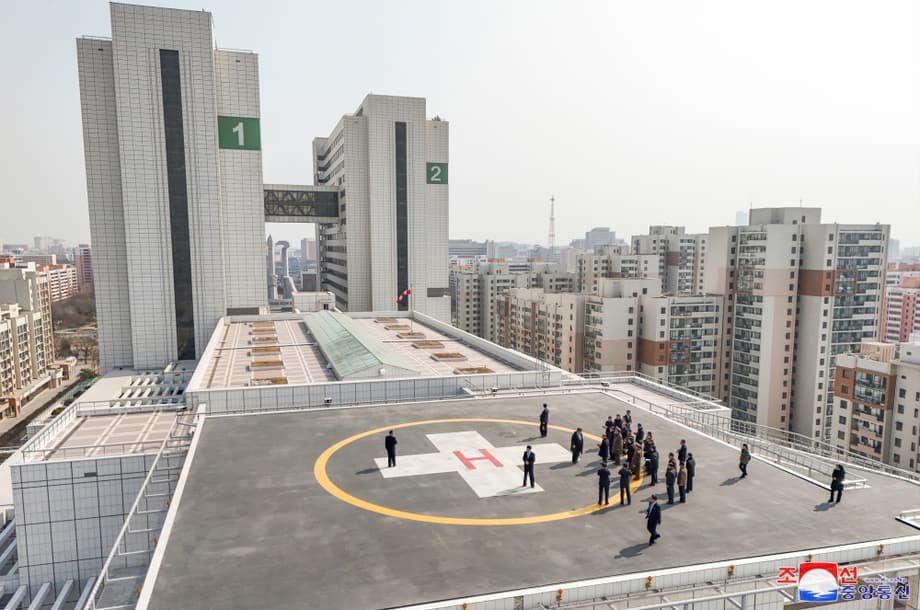A showcase hospital with missing core technology
North Korea has begun admitting patients at Pyongyang General Hospital, a long promised project that state media calls world class. The building presents a polished face, with a sweeping atrium, a helipad, and conference halls. Inside, the picture is different. Images released by official outlets in the country show a small set of machines, including a computed tomography scanner and X ray units. There is no sign of a magnetic resonance imaging system, no positron emission tomography scanner, and no clear view of modern laboratory analyzers. The contrast between the marquee exterior and the sparse equipment has renewed questions about how far the country can modernize care under tight restrictions on trade and finance. The hospital opened after more than five years of construction. It was first unveiled in early 2020 as a centerpiece for public health upgrades.
- A showcase hospital with missing core technology
- What the images reveal inside the flagship facility
- Sanctions, shortages, and the politics of medical imports
- Kim Jong Un’s timeline and an unfinished promise
- The Russia factor and a possible equipment lifeline
- Can a hospital be world class without MRI and modern labs
- Health care promises beyond Pyongyang
- What patients are likely to experience today
- Key Points
Kim Jong Un pledged to finish the complex within seven months in 2020. The timeline slipped amid shortages of materials and the onset of the pandemic. The shell of the structure rose quickly, but installing equipment and staffing took far longer. The launch offers the leadership a platform to signal progress. Patients can now be received in a setting that looks like a capital city flagship. The question is what level of diagnosis and treatment can be delivered without the systems that define modern tertiary hospitals. Medical imaging is the backbone of advanced care. Without a robust suite that includes MRI, modern ultrasound, and specialized lab instruments, doctors face real limits on how precisely they can detect disease.
Analysts who reviewed the visuals see a gap between design and capability. Sanctions restrict many high tech imports. Banking channels are constrained and logistics are complicated. Even technology that is not directly banned can be hard to pay for or ship. The result is a hospital that looks ready for complex work on the outside, while the inside still waits for the tools that would make that work possible.
An official at South Korea’s Unification Ministry reviewed official photos and video from the opening and shared an assessment of the equipment on display. The comment underscores the reality of procurement under international pressure and limited access to suppliers.
“The facility struggled to secure high priced medical equipment. The most expensive device seen during Kim’s inspection was a CT scanner.”
What the images reveal inside the flagship facility
The material released in the country highlights an entrance hall, meeting rooms, and patient areas that appear recently finished, along with a CT scanner and X ray machines ready for use. What is missing in that imagery is just as important. There is no MRI suite, no angiography lab for heart and stroke interventions, and no clear evidence of updated laboratory automation or information systems. It is possible that some equipment exists out of view or is scheduled for later installation, yet the current presentation points to a hospital that can handle routine imaging and basic inpatient care rather than the full range of complex services associated with a major referral center.
CT and MRI do different jobs
CT uses X rays to create cross sectional images of the body. It is fast and excellent for trauma, lung disease, and many cancers. MRI uses strong magnets and radio waves to map soft tissue with superior detail. It is essential for brain and spinal cord disorders, ligament and tendon injuries, and many pediatric conditions. Without MRI, clinicians can still diagnose many problems, but they face added uncertainty in neurology, orthopedics, and oncology where MRI often answers questions that CT cannot resolve.
What a high level hospital usually needs
A hospital that seeks world class status typically runs multiple imaging modalities, including MRI, CT, advanced ultrasound, mammography, and interventional suites for heart and vascular procedures. It supports these with modern laboratory analyzers for blood, chemistry, and microbiology, digital records that connect imaging and lab results to charts, reliable medical gas and oxygen systems, sterilization, and negative pressure rooms for infection control. Intensive care requires ventilators, infusion pumps, monitors, and around the clock power with tested backup. Surgical theaters need anesthesia machines, imaging guidance, and a full supply chain for sterile tools and implants. The current public materials show only a small fraction of that landscape.
Sanctions, shortages, and the politics of medical imports
United Nations sanctions target the country’s weapons programs, but the ripple effects reach civilian sectors. Medical devices often contain advanced electronics, specialized magnets, and software that fall under export control regimes. Humanitarian exemptions exist on paper. In practice, licensing, banking, and shipping hurdles can block deliveries for months or years. Financial sanctions make it difficult to transfer funds. Global suppliers, wary of penalties, tend to walk away from transactions that carry added risk, even when the items themselves can be exported lawfully.
There is also the issue of service and parts. High end scanners need regular maintenance, replacement tubes and coils, and software updates. Those require travel by engineers or secure remote connections, both of which are restricted. The country’s strict border closures during the pandemic compounded those barriers, cutting trade and limiting aid flows. Even if money and permissions line up, the lack of local distributors and trained service teams turns each delivery into a one off project with fragile follow up. That reality helps explain the sparse equipment list visible in Pyongyang’s new showcase.
Kim Jong Un’s timeline and an unfinished promise
The leader broke ground on the hospital in March 2020 and framed it as a priority project that would be complete in time for an October celebration. As work dragged, he visited the site and scolded managers. State media said he criticized careless economic organization, poor budgeting, and deviation from party policy in the supply of equipment and materials. He also ordered an investigation of those responsible and called for replacements. The message was clear, finish the building and do it the right way, even as border controls and shortages bit into schedules.
Construction teams pressed ahead on rotating shifts as the exterior neared completion, yet the interior and the equipment lagged. To push materials into the capital, authorities tapped a veteran cadre known for managing industrial production to direct procurement. Shipments accelerated, but the final stages still required years. The hospital is now open to patients, a visible milestone that arrives without the broad technology base many expected when the project was first announced.
The Russia factor and a possible equipment lifeline
Moscow has moved to expand health cooperation with Pyongyang. The Russian health minister, Mikhail Murashko, visited the capital recently for talks with the country’s public health minister about medical equipment and pharmaceuticals. Russian experts toured Pyongyang General Hospital during the trip. The Russian embassy described the discussions, and public photos showed delegations walking the site. The visit suggested an interest in filling the technology gaps that the hospital’s opening put on display.
Russian leaders also discussed helping North Korea build a new hospital during a summit in Pyongyang in mid 2024, part of a broader set of bilateral agreements. Russia manufactures CT scanners, ultrasound machines, and a range of hospital equipment, and it has access to third country suppliers that may be willing to sell. The next questions are practical ones. How to finance purchases, how to move heavy equipment through borders, and how to maintain it over time. If those hurdles can be managed, Russian support could bring significant upgrades, from imaging to lab systems. If they cannot, cooperation risks becoming a series of photo opportunities without durable changes in patient care.
Can a hospital be world class without MRI and modern labs
World class status is more than branding. It means routine access to complex diagnosis, rapid interventions, and safe care supported by reliable infrastructure. MRI helps surgeons plan brain operations, helps oncologists stage tumors, and helps sports medicine teams see torn ligaments. Interventional suites take patients from a stroke or heart attack to treatment in minutes. Infection control depends on ventilation standards, isolation rooms, and sterilization that meet global norms. Electronic records tie it together so teams can see a full picture of each patient across departments.
A facility with CT and X ray can do a lot. Clinicians can triage trauma, find fractures, detect many cancers, and assess pneumonia. For many common conditions, CT offers clear answers. Where the limits show is in soft tissue detail and in precision tasks like brain imaging for epilepsy or subtle strokes, and in vascular imaging without contrast. Without a visible MRI suite and modern labs, the new hospital looks ready to deliver basic inpatient and emergency services, but it falls short of the tool set that would justify a world class label in a medical sense.
Health care promises beyond Pyongyang
In recent months the leadership has widened its pitch from one capital project to a nationwide program. Under the Regional Development 20X10 policy, authorities plan to build twenty factories in cities and counties each year for a decade to lift material and cultural life. That program was later expanded to include hospitals and science and technology centers. The leader attended a groundbreaking ceremony for a county hospital near the capital and called modernization of regional health services a priority. He said the goal is to erase the gap between towns and the countryside so that people across the country enjoy the same cultural level.
During that event, Kim highlighted the central message in plain terms.
“Modernizing and advancing public health services is a top priority.”
He also acknowledged the hard parts, from acquiring medical equipment and tools to finding the technology, materials, and finances needed to finish hospitals and keep them working. Plans now call for building twenty hospitals across cities and counties each year starting in 2026. The scale of that ambition, and the constraint of sanctions and limited resources, set the stage for more foreign outreach as the government looks for ways to stock facilities with the machines and supplies that clinicians require.
What patients are likely to experience today
For patients walking through the doors now, the experience will likely be a blend of new surroundings and familiar constraints. A CT scanner expands diagnostic options for head injuries, chest and abdominal pain, and many cancers. X ray units support the emergency room and wards. General surgery, obstetrics, pediatrics, and internal medicine can operate with these tools, and many lives can be improved with reliable basic services. Without ready access to MRI and to modern laboratory diagnostics, however, teams will need to refer complex cases or rely on clinical judgment and older methods where equipment is missing. The difference matters most for neurological disease, some cardiac care, and oncology staging, where precise imaging often drives the choice of therapy.
It is possible that additional equipment will arrive in phases. Even when machines are purchased, a hospital needs trained operators, physicists and engineers, secure power, and maintenance contracts. Spare parts and software updates must cross borders on a schedule that works for patient care. If the partnership discussions with Russia turn into concrete deliveries and service support, Pyongyang General Hospital could evolve toward the role its builders envisioned. If not, the site risks becoming a symbol of architectural ambition constrained by technology that lags behind its facade.
Key Points
- Pyongyang General Hospital has opened after more than five years of construction, with state media calling it world class.
- Official imagery shows CT and X ray machines but no MRI or other high end diagnostic systems.
- A South Korean Unification Ministry assessment concluded the hospital struggled to secure expensive medical equipment.
- Sanctions, banking limits, and service barriers complicate the purchase, delivery, and maintenance of advanced devices.
- Kim Jong Un launched the project in 2020 with a seven month target, later reprimanding managers as delays mounted.
- Russian officials visited Pyongyang to discuss medical cooperation, and Moscow has signaled support for future hospital projects.
- The leadership plans to build twenty hospitals a year starting in 2026 as part of the Regional Development 20X10 policy.
- Without MRI and modern labs, the new facility can handle basic inpatient and emergency care but lacks tools that define a top tier referral center.




